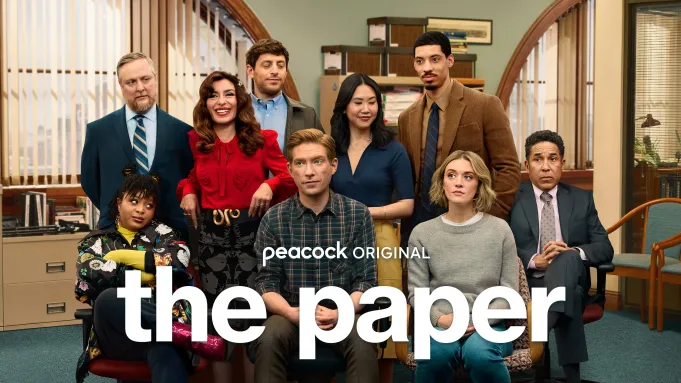The world of the beloved sitcom, The Office, has been expanded with The Paper, but how is it as a standalone?
In a world of Abbott Elementary and Modern Family, another mockumentary-style sitcom may not seem like anything exciting. But, The Paper is different because of one special detail: It takes place in the same universe as The Office.
For those who don’t know — though it’s hard not to — The Office was a mockumentary that premiered in 2005, based on the British show starring Ricky Gervais. The premise follows a camera crew documenting the daily life of a mundane, regional paper company. Over nine seasons, the series explores the romance, drama, comedy and memories that unfold inside the office.
In The Paper, the same camera crew decides to follow a local newspaper, The Toledo Truth Teller, for their new documentary. The show opens with Ned Sampson, played by Domhnall Gleeson, being introduced as the paper’s new editor-in-chief. He wants real journalism for a newspaper that had previously relied solely on the AP News wire and clickbait headlines.
The main expectation for The Paper is whether it can compare to The Office, a show that won five Primetime Emmys. In that sense, it definitely captures a similar feel, especially with the return of Oscar, played again by Oscar Nunez, who references moments from the original series. With the occasional blank stares at the camera, awkward pauses and unconventional romances, it’s clear the two shows share a universe.
Scene from "The Paper." Photo provided by Peacock
The Paper has the potential to become a comforting show, one that’s easy to binge and rewatch.
One aspect of this “bingeability” would be the comedy — the show definitely has its moments worthy of a good laugh. Although, it lacks the consistency with the tone occasionally becoming too serious or just dull. Some storylines take a while before they gain momentum and enter the realm of comedy.
Familiar character types — the everyman, the oddball, the try-hard and the slacker – are also evident. These commonalities exemplify the challenges when creating a follow-up series in a well-worn genre.
One character in particular makes the show hard to watch at times: Esmeralda Grand. Sabrina Impacciatore does such a good job of playing this chaotic foil character that she gets to be genuinely unbearable at times.
While she is meant to be the saboteur, she can still be over the top and abrasive. Either that or just unfunny, putting too much reliance on her accent and purposeful mispronunciation of words for humor instead of real written comedy.
One thing The Paper does well is the choice of setting: a small Ohio newspaper. It’s important to have a show about original journalism during a time when journalism itself is being threatened. Portraying journalists in a lighthearted way helps combat the stigma that often surrounds the profession. For once, they aren’t just rude or cynical caricatures, but people with passion and integrity.
The Paper touches upon anxieties about journalism and the decline of local news outlets — this really applies to today’s world with big companies like The New York Times and The Wall Street Journal controlling a large majority of the news we consume. A recurring idea in the series is that the “villain” of a local newspaper isn’t necessarily a rival publication, but digital giants and ad platforms that take the attention and revenue.
As a standalone series, The Paper is good, but its structure isn’t anything special. With only the first season released, some extremely predictable romances are already developing. A prolonged “will-they-or-won’t-they” storyline is expected between Ned Sampson and his employee Mare Pritti played by Chelsea Frei, echoing the formula of many sitcoms.
The Office was arguably one of the first mockumentaries to gain mainstream success and leave a lasting mark on pop culture. That success made the show’s format incredibly popular. Now, with the introduction of The Paper, new creative routes need to be taken to keep the style fresh. The format may be tried and true, but that doesn’t mean creators should shy away from taking risks.
Centering the show on a newspaper is a promising choice, but hopefully, season two brings more surprises.



